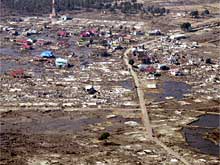Common menu bar links
Institutional links
Diseases & Conditions
Health & Safety
Research & Statistics
Agency Information
Search Box
Media availability - January 10, 2005
Remarks by Dr. Paul Gully
Deputy Chief Public Health Officer, Public Health Agency of Canada
Banda Aceh on the island of Sumatra |
Boats washed ashore in Sri Lanka Photos are courtesy of Dr. Paul Gully |
Check against delivery
As David Butler-Jones has said, I was part of the Government of Canada reconnaissance mission to Sri Lanka and Indonesia to assess how Canada could further respond to the events of December 26, 2004.
I would like to give you some personal impressions from this brief assignment.
It is still hard to comprehend the personal and socio-economic consequences of the earthquake and tsunami. The extent of the devastation is shocking.
The mission talked to government, United Nations (UN) and non-government organization (NGO) representatives at many levels, and their co-operation and willingness to assist was invaluable. The importance of having health expertise in the group was clear. The situation in each country is very different, geo-politically and in relation to the development of its health system. These differences reflect the ability of a country and agencies already in place to respond.
The Government of Canada is contributing to the prevention of ill health by working with the UN, other agencies and NGOs who are providing water, food and shelter. With respect to the specific public health response, Canada is contributing by giving direct assistance (e.g., the DART) and the PHAC has offered support for surveillance, investigation and a unique mobile laboratory. Needs vary and will be defined in discussions with those in each country.
There will be an on-going public health need for some time, especially for surveillance of disease and non-physical trauma as the numbers of displaced persons who will be living in temporary camps will be very large.


